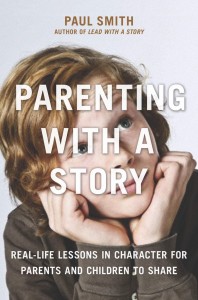Business & Life Skills
Why storytelling is an effective leadership skill? (Paul Smith)
How can you spice up a standard business meeting with a story? Learn why a story can engage, inspire, and captivate. Plus, Paul Smith author of “Lead with a Story: A Guide to Crafting Business Narratives that Captivate, Convince, and Inspire” and “Parenting with a Story: Real-life Lessons in Character for Parents and Children to Share” shares his favorite stories that you can reuse in the office or at home.
Why storytelling is an effective leadership skill
In his book “Lead with a Story”, Paul Smith shares why storytelling is the key to inspiring and convincing your team. He shares the following reasons:
Story telling is simple? Anyone can do it. You don’t need a degree in English, or even an MBA.
Story telling is timeless. Unlike fads in other areas of management, storytelling has always worked for leadership, and it always will.
Stories are demographic-proof. Everybody – regardless of age, race, or gender – likes to listen to stories.
Stories are contagious. They can spread like wildfire without any additional effort on the part of the storyteller.
Stores are easier to remember: According to psychologist Jerome Bruner, facts are 20 times more likely to be remembered more accurately, and far longer than the learning derived from facts or figures.
Stories inspire. Slides don’t.
Stories appeal to all types of learners: In any group, roughly 40% will be predominantly visual learners, 40% auditory, and 20% kinesthetic learners. Storytelling has aspects that work for all three types.
Stories fit better where most of the learning happens in the workplace. According to communications expert Evelyn Clark “Up to 709 percent of the new skills, information and competence in the workplace, is acquired through informal learning” such as what happens in team settings, mentoring, and peer-to-peer communications. And the bedrock of informal learning is storytelling.
Stories put the listener in a mental learning mode. Listeners who are in a critical or evaluative mode are more likely to reject what’s being said. According to training coach and best-selling author Margaret Parkin, storytelling “re-creates in us that emotional state of curiosity which is ever present in children, but which as adults we tend to lose”. As author and organizational narrative expert David Hutchens points out, Storytelling puts the listeners in a different orientation.
Telling stories shows respect for the audience. Stories get your message across without arrogantly telling listeners what to think or do. Regarding what to think, storytelling author Annette Simmons observed, “Stories give people freedom to come to their own conclusions. People who reject predigested conclusions might just agree with your interpretations if you get out of their face long enough for them to see what you have seen. As for what to do, corporate storyteller David Armstrong suggests, “If there was ever a time when you could just order people to do something, it has long since passed. Telling a story, where you underline the moral, is a great way of explaining to people what needs to be done, without saying, “do this” – p12
Paul Smith YouTube Video: Why storytelling is a hallmark of all great leaders?
0:41 How does storytelling fit within the normal course of business?
3:51 Why is storytelling a key ingredient in leadership?
AMA: Why is storytelling such an important leadership tool?
What is the best structure of a story?
Smith asks us to recall our childhood days where each story begins with “Once upon a time, there was …”. This is a natural story structure that is easy to remember because it introduces a character (context), explains what happens with the character (action), and reveals how the story ends (result). To learn more go to: http://www.lynda.com/Business-Skills-tutorials/Structuring-your-stories/157131/161401-4.html
Context – Background information
The context of a story should include a solution to these four key questions.
- Who is the main character?– The main character is someone your audience can connect with.
- What does he or she want?– Explain your main character’s goal, mission, or purpose.
- Where and when does this story take place?– Establish “where” the story takes place. Clarify whether it’s fact or fiction and when everything happened.
- Who, or what, is in the way?– Every story needs a challenging roadblock or villain that the hero must tackle.
Action – The challenge
Every great story has its ups and downs, conflicts, wars, failures, and obstacles, all of which are designed to teach us a lesson. Obstacles create tension and engage the listener to care about the main character, as well as relate to the human experience.
Result – moral of the story
At the end of your story, your main character should have overcome obstacles and revealed their fate. The listener is to interpret and create a subjective sense of what the story means to them.
When to use a storytelling in Business?
Paul Smith spoke to hundreds of experts to write both of his books “Lead with a story” and “Parenting with a Story”. In the video below, he explains the process he used to come up with these stories:
How story telling can help with The key business problems?
In his book “Lead with a Story”, Paul focused on how storytelling has helped businesses overcome common leadership challenges through it’s method of leading, captivating, convincing, and inspiring the team https://youtu.be/nuShvuPJNZ0?t=12m37s. He explains how storytelling is more of a leadership tool than a management tool.
TACTICS: How to persuade using a story? click to video answer
Paul shares storytelling advice in a Forbes magazine article:
First, the biggest barrier to telling stories at work is not having any stories to tell. That’s one of the main reasons I wrote this book—to give executives a reference of 100+ proven stories used by other leaders to help navigate the most common challenges they face. But you can also start collecting your own stories. So pay attention. When something teachable and memorable happens to you, write it down. A great story is about to be born.
Second, there are seven elements I advocate to turn a good story into a great story.
Start with the context. Ever heard someone excitedly launch into a story and soon the listeners are scratching their heads? The teller stops and says something like, “Oh, wait, I guess I should back up a bit and explain why all this happened. You see, my boss had just gotten fired, and so . . .” . That’s the sign that the storyteller skipped the context. If they’re lucky, the confused look on their audience’s faces will remind them to go back and tell the context. If they’re not lucky enough to notice, their story is doomed to mediocrity.
Use metaphors and analogies. A well-chosen metaphor can add to the impact of a story, or replace a story entirely, because there are already entire stories attached to those few words in your audience’s brain, waiting for you to tap into (for more check out transcript at: http://www.lynda.com/Business-Skills-tutorials/Using-metaphors-analogies/157131/161404-4.html)
Appeal to emotion. Studies show people make decisions largely based on emotional reasons, and then rationalize them afterwards so they feel logical. Great leaders know this intuitively, and aren’t afraid to lead with both sides of their brain. (Check out transcript of tutorial: http://www.lynda.com/Business-Skills-tutorials/Using-emotion/157131/161402-4.htm)l
Keeping it real (for more check out transcript at: For http://www.lynda.com/Business-Skills-tutorials/Keeping-real/157131/161405-4.html)
Keep it tangible and concrete. Avoid mind-numbing vague generalities and weasel words typical of management speak today. Keep stories specific and concrete and they’ll be more engaging and memorable.
Include a surprise. Surprises not only get your audience to sit up and pay attention, they make your story more memorable. Studies show surprise triggers the release of adrenaline in the brain that heightens memory formation.(Check out transcript of tutorial: http://www.lynda.com/Business-Skills-tutorials/Using-surprise/157131/161403-4.html)
Use a narrative style appropriate for business. Be concise and to the point. Business narratives should be 3-5 minutes long. Leave the long soliloquy for your first screenplay.
Move beyond telling your audience a story to creating a scene or event for them to participate in. While a good story is a close second, experience has always been the best teacher. If you can turn your story into an event that your audience takes part in, it will be even more effective. Don’t just tell them about when you found out by accident that your competitor’s product worked better than yours. Stage an impromptu” — http://www.forbes.com/sites/danschawbel/2012/08/13/how-to-use-storytelling-as-a-leadership-tool/2/ Retrieved September 5, 2015.
Paul Smith YouTube: Tips on Good story telling
- 15:05How would you introduce a story in a business context? (e.g- introduce story in annual goal setting)
- 19:08Why are stories about other people critical to storytelling?
- 18:31Role playing: Paul demonstrates how he would introduce a story into a meeting.
- 22:15How to ensure the “lesson” of a story is understood by your audience
- 26:56What NOT to do when telling a story
Stories for common business problems
STORY: How do you get people to appreciate the importance of business planning?
- 10:09How to share a lesson through your story? (e.g.-annual goal setting)
- 18:46Paul Shares the story of Bob McDonald on goal setting.
https://youtu.be/nuShvuPJNZ0?t=4m58s
STORY: how do you persuad by suggesting versus tell someone what to do?
https://youtu.be/nuShvuPJNZ0?t=8m11s
STORY: Leading change- How you can use storytelling to ease transition?
https://youtu.be/nuShvuPJNZ0?t=9m39s
Story: Getting people to work and collaborate together?
- 34:09What stories can you tell to encourage collaboration in a meeting?
- 37:20How can storytelling create greater collaboration and teamwork?
Story: Setting a vision for the futUre
- 8:06What are three types of stories that should be told when setting a group or divisional vision?
- 32:00How would you tell a story when setting a vision?
Storytelling at home
- 40:58 Paul Smith shares the stories he loves to tell his kids (e.g.- quiche story and how to be your own person)
- 46:28What are some favorite kid-approved stories? (e.g.- story of kindness- Chad basketball player)
About Paul Smith – Speaker, Author, and Leading Expert on Business Storytelling

Paul Smith is a one of the world’s leading experts on business storytelling. He’s a keynote speaker, storytelling coach, and bestselling author of the booksLead with a Story and Parenting with a Story.

Connect with him via email here.
Follow him on Facebook, LinkedIn, Twitter.
Sign up for his newsletter here to get one new story a week delivered to your inbox.



